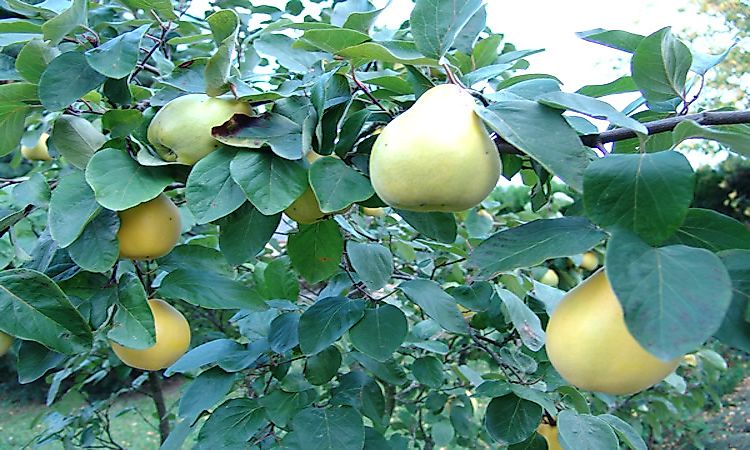The Top Quince Producing Nations In The World

What Is Quince?
Quince is a small deciduous tree that bears a pome fruit. The fruit is bright yellow and golden when mature and has been traditionally used for food. The fruit also has various uses because of its ornamental qualities especially when planted. The tree grows up to 5-8 m tall and 4-6 m wide. The fruit reaches a height of 7-12cm. The immature fruit is green with grey-white pubescence which rubs off before it matures in late autumn. Its seeds contain nitrites which when swallowed gets hydrolyzed in the stomach to produce hydrogen cyanide which is a volatile gas and can be toxic if large quantities are consumed. The tree is native to the rocky slopes and woodland margins in the Asian countries such as Armenia and Turkey. However, it is also capable of surviving in higher altitudes as far as Scotland. Quince season fruits start in September. The tree was brought to America from the Middle East. In the market, it is instructive to pick the yellow ones and avoid the green and bruised ones as they are bitter and inedible. Once at home, they can stay for a week or more when stored in cool and dry places.
Uses Of Quince
Quinces are appreciated for their strong aroma. Even when ripe, they are hard and need some kind of softening to be edible. They are subjected to bletting by frost and decay to make them suitable for consumption. They may also be cooked and roasted, used for jam, marmalade and pudding. Quinces may be baked or stewed. It is also used as a drink with some level of alcoholic content. The fruit is crushed and mixed with boiling water after which fermentation takes place for some days. It gets diluted with distilled water to produce the final product. In the Alsace region of France and Valais region of Switzerland, the liquor is used as a digestif. The tree also has cultural significance. In the Balkans when a child is born, the quince is planted as symbol of fertility, love, and life.
Cultivation And Production Of Quince
The tree requires soil with moderate moisture, porous and rich in nutrients. Highly calcareous soils threaten to affect the crops with chlorosis. Once the crop is established, it performs well in soils that have 2%-3% humus content. Research has shown that it performs well even with slightly lower humus content. The yield per tree is 10-60 kg on the plantation while those growing individually can produce 100-400kg.
Top Quince-Producing Countries
The top three leading countries are in Asia. Turkey is at the top followed by China and Uzbekistan in the third place. Morocco, Iran, Argentina, Azerbaijan, Spain, Serbia, and Algeria are the other countries on the top ten in terms of the crop production.
Significance Of Quince
Quince is a favorite crop globally although it does not yet compete favorably with the likes of lemon and orange. It has dietary and other non-dietary purposes. The crop performs well in diverse regions even though its native place of origin in the rocky terrains of Southern Asia.
The Top Quince Producing Nations In The World
| Rank | Country | Quince Production (in metric tons) |
|---|---|---|
| 1 | Turkey | 135,406 |
| 2 | China | 125,000 |
| 3 | Uzbekistan | 80,000 |
| 4 | Morocco | 46,000 |
| 5 | Iran | 36,500 |
| 6 | Argentina | 27,500 |
| 7 | Azerbaijan | 27,140 |
| 8 | Spain | 14,000 |
| 9 | Serbia | 10,795 |
| 10 | Algeria | 10,516 |











